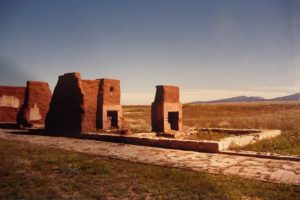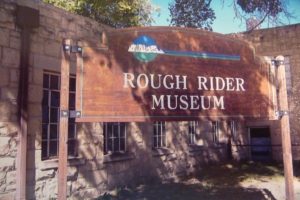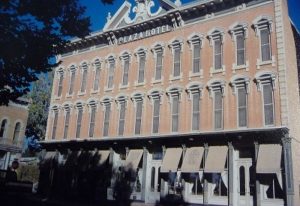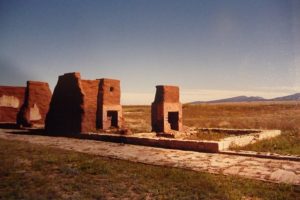02 Jul The Authentic Spirit of the Old West – New Mexico’s Las Vegas

Author: Ronnie Greenberg
Photos by: Joe Hilbers
Ronnie Greenberg
5310 Dubois Ave
Woodland Hills, CA 91367
(818) 347-7437
mrg5310@aol.com
The Authentic Spirit of the Old West – New Mexico’s Las Vegas
By: Ronnie Greenberg
Photos: Joe Hilbers
Cradled in the beauty and seclusion of Northern New Mexico, the spectacular mountain community of Las Vegas in San Miguel County celebrates its history and culture with festivals and fiestas. In 1835 on the heels of a rich and tumultuous past, the city evolved on the site that’s now Old Town Plaza. Spanish for “the meadow” Las Vegas was a land of promise when the Santa Fe Trail was routed through what is currently Bridge Street, South Pacific Avenue, and the Plaza. It became a hub for the Atchison-Topeka & Santa Fe Railroads in 1879, and when the railroad built its’ depot, New Town began to bustle with new businesses and sprawling Victorian mansions. Frontier Las Vegas was now in its heyday with strong cultural and social ties to the charity balls, opera house, literary clubs, the orchestra and theater. To add to the glamour, the area’s hot springs and luxury resorts began luring wealthy patrons from the east and as far away as Europe.
At the same time it was cosmopolitan and respectable, it also earned a reputation as one of the rowdiest cities in the west. Along with many enterprising individuals, the Santa Fe Trail brought several colorful characters to Las Vegas including Billy the Kid, Jesse James, Doc Holiday, Big Nosed Kate Elder, and the Durango Kid, all of who wreaked havoc on the townspeople.
By the turn of the 20th century, the town that had always been a quirky haven for artists of all types also began luring celebrities. Tom Mix, the famed actor and director filmed an incredible 16 movies in Las Vegas during 1915. Mix’s films were the first of many to be filmed in Las Vegas. Still a popular site for movies modern films include Easy Rider, Convoy, Red Dawn, Wyatt Earp, The Lazarus Man, All the Pretty Horses and Walker, Texas Ranger: Last of a Breed.
Enchantingly suspended in time, Las Vegas has reclaimed its treasure once again through the restoration and revitalization of the city, and as a thriving cultural center. High on the National Register of Historic places, Las Vegas boasts over 900 buildings ranging from indigenous adobes to grand Victorian mansions.
Recreational activities and areas
Along with its astounding geology, glorious landscapes that sweep across a stunning mountain range, a vast wilderness area, lush forestlands, pristine lakes and waterways, all offer a wide variety of year round outdoor activities.
Storrie and Conchas Lake State Parks provide a variety of camping, fishing, boating and windsurfing opportunities. Las Vegas National Wildlife refuge is a haven for hikers who enjoy nature, plant and animal life. Native grasslands, croplands, marshes, ponds, timbered canyons and streams provide almost 9,000 acres of refuge for over 270 species of birds and other wildlife. You can soak in natural hot springs, play golf nearby at New Mexico Highlands University, or climb to the top of Hermit’s Peak for spectacular views of the plains to the east, and the Sangre de Cristo Mountains to the west. There are also great trails in the Santa Fe National Forest including the Pecos Wilderness area. Roads leading north and west from Las Vegas are almost immediately in pine country and wander through scenic valleys and canyons.
Stop by the Santa Fe Trail Interpretive Center where photos and artifacts of the area’s settlers tell a colorful tale. Brochures and maps are available for self-guided adventures.
Historic Districts
A stroll through Old Town Plaza at the top of Bridge Street is a cultural event and link to the past. You can sample the lively boutiques and galleries offering specialty clothing stores, books, collectibles, antiques, spices, toy shops, bakery and coffee shops. Watch weavers work the looms at Tapetes de Lana, and other area craftsmen create custom jewelry, leather goods, local art and pottery. The El Districto de Las Escuelas highlights La Casa Redona a 14-room house built in a circle around a central courtyard. The Old Town residential district is where the Jack Johnson house served as the training camp for the former World Heavyweight Boxing Champion. The Railroad District still has the remnants of the La Castaneda Hotel, once the jewel of the famed Harvey hotels from the late 1880s. The Carnegie Park District features the Carnegie Library modeled after Thomas Jefferson’s home at Monticello. It was built in 1903 with money granted by famed tycoon Andrew Carnegie and is still an active library. The New Mexico Highlands University’s Ilfeld Auditorium, built in 1941, is still the site of theatrical and musical productions. The Lincoln Park District boasts some of New Mexico’s best 19th century railroad-era boom architecture; and North New Town is a beautiful residential neighborhood with a variety of architectural styles.
Sites to see
Montezuma Castle (Armand Hammer United World College) The most luxurious of all the Victorian structures built in Las Vegas is the Montezuma Castle whose towers, turrets, gables, balconies and verandas evoke a romantic past. This monolith was originally erected in 1882 by the Atchison, Topeka and Santa Fe Railroad, as a thermal bath resort. A fire burned the hotel to the ground in 1884. It was rebuilt a year later and burned down once again. It reappeared in 1886, this time as the Phoenix Hotel. Its guest roster throughout the years included Theodore Roosevelt, Ulysses S. Grant and Jesse James. The hot springs are still in existence below the castle.
 Pecos National Historical Park preserves 12,000 years of historical treasures including the ancient pueblo of Pecos, two Spanish Colonial Missions, Santa Fe Trail sites, and the site of the Civil War Battle of Glorieta Pass/ For information phone (505) 757-6032 or the website at: https://www.nps.gov/peco
Pecos National Historical Park preserves 12,000 years of historical treasures including the ancient pueblo of Pecos, two Spanish Colonial Missions, Santa Fe Trail sites, and the site of the Civil War Battle of Glorieta Pass/ For information phone (505) 757-6032 or the website at: https://www.nps.gov/peco
Fort Union National Monument a captivating site located along the Santa Fe Trail was once the largest military outpost in the American Southwest. The fort was built in 1851 to protect the Santa Fe Trail, and served as a base of operations against Indian uprisings and later outlaws.
Fort Union is being preserved as an outdoor museum and is administered by the US National Park Service The interpretive museum at Fort Union presents an overview of life on the frontier and along the Santa Fe Trail. There’s also a 1.6 mile self-guided tour where you can see the wagon ruts alongside the Santa Fe Trail, and get to view the ruins of the second and third fort. For more information phone (505) 425-8025 or the website at: https://www.nps.gov/foun
 Las Vegas Museum and Rough Rider Memorial Collection – In 1898 America was convinced that it should help the Cubans win their independence from Spain. Teddy Roosevelt came to New Mexico to recruit volunteers for his Rough Riders cavalry regiment, and twenty-one men from Las Vegas signed on. The following year the first annual Rough Riders Reunion was held in Las Vegas at which time the National Association of Roosevelt Rough Riders was formed. Teddy Roosevelt, then Governor of New York with more than 600 of his comrades, attended it. It was voted to hold all subsequent reunions here “to the last man,” That came to pass in 1968. The museum eloquently shares the past with remarkable collections of Rough Rider uniforms, arms, maps and newspapers and artifacts of the era. Phone (505) 454-1401 for information.
Las Vegas Museum and Rough Rider Memorial Collection – In 1898 America was convinced that it should help the Cubans win their independence from Spain. Teddy Roosevelt came to New Mexico to recruit volunteers for his Rough Riders cavalry regiment, and twenty-one men from Las Vegas signed on. The following year the first annual Rough Riders Reunion was held in Las Vegas at which time the National Association of Roosevelt Rough Riders was formed. Teddy Roosevelt, then Governor of New York with more than 600 of his comrades, attended it. It was voted to hold all subsequent reunions here “to the last man,” That came to pass in 1968. The museum eloquently shares the past with remarkable collections of Rough Rider uniforms, arms, maps and newspapers and artifacts of the era. Phone (505) 454-1401 for information.
Victory Ranch is a working ranch where you can hug and feed one of the largest herds of alpacas in the Southwest. Alpacas, small gentle cousins to Llamas are native to the South American Andes and are very much at home in the Mora Valley. Tour the visitors center, try your hand at spinning and weaving, and browse the beautiful 3,000 square foot clothing and gift shop filled with garments, rugs, yarn, fiber, and local art. For information phone: (505) 387-2254 or visit website at: https://www.victoryranch.com
Where to stay


 The Historic Victorian Plaza Hotel a three-story Italianate-style building was erected in 1882 to accommodate the influx of travelers that were flocking to the area. Some of the heroes and hooligans of American folklore hung their hats at the Plaza Hotel including Billy the Kid, Vicente Silva, Voodoo Brown and Doc Holiday. In 1982, one hundred years after its beginning, a two-million dollar restoration returned the Plaza to the glory of its early reign as the “Bell of the Southwest.” Located at 230 Plaza Park, (800) 328-1882 or the website at https://www.plazahotel-nm.com
The Historic Victorian Plaza Hotel a three-story Italianate-style building was erected in 1882 to accommodate the influx of travelers that were flocking to the area. Some of the heroes and hooligans of American folklore hung their hats at the Plaza Hotel including Billy the Kid, Vicente Silva, Voodoo Brown and Doc Holiday. In 1982, one hundred years after its beginning, a two-million dollar restoration returned the Plaza to the glory of its early reign as the “Bell of the Southwest.” Located at 230 Plaza Park, (800) 328-1882 or the website at https://www.plazahotel-nm.com





Sorry, the comment form is closed at this time.